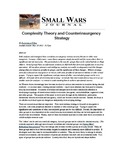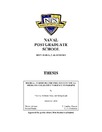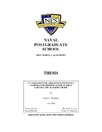Complexity theory and counterinsurgency strategy
| dc.contributor.author | Cline, Lawrence | |
| dc.date | March 18, 2012 | |
| dc.date.accessioned | 2016-01-12T17:03:41Z | |
| dc.date.available | 2016-01-12T17:03:41Z | |
| dc.date.issued | 2012-03-18 | |
| dc.identifier.citation | Small Wars Journal: Journal Article March 18, 2012, 8:17pm | en_US |
| dc.identifier.uri | https://hdl.handle.net/10945/47523 | |
| dc.description.abstract | Both analysts and strategists have a tendency to categorize various security threats in rather neat categories. In many – likely most – cases these categories simply do not fit well for areas where there is significant internal insecurity. This particularly is the case for groups that can be called hybrids or shape shifters. Armed groups have an unfortunate tendency to shift both their form and significance to security operations. All too often, planners and intelligence analysts are unable to adequately track the changes among what are viewed as peripheral groups, and the significance of these changes. Military strategy normally is focused on insurgents or terrorists, with some peripheral attention to militias or other armed groups. Trying to unpack the significance and operations of other, non-included groups can be very difficult. A broader form of environmental sensing – to include how intervention forces may serve as yet another actor for analysis – is critical in understanding how to achieve operational success. | en_US |
| dc.publisher | Small Wars Journal | en_US |
| dc.rights | This publication is a work of the U.S. Government as defined in Title 17, United States Code, Section 101. Copyright protection is not available for this work in the United States. | en_US |
| dc.title | Complexity theory and counterinsurgency strategy | en_US |
| dc.type | Article | en_US |
| dc.contributor.department | Center for Civil-Military Relations | en_US |
| dc.description.distributionstatement | Approved for public release; distribution is unlimited. |





